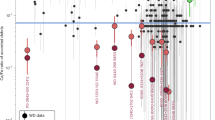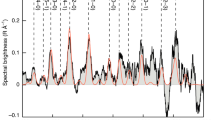Abstract
In 1967, Hartmann & Larson1 and Fish2 pointed out a relationship between the 'angular momentum density' (angular momentum per unit mass) and mass of the planets and asteroids, which was interpreted as resulting from the primordial accretion of these objects. These authors noted that this relationship holds if the planets rotate with approximately the same period, without taking into account density variations, and Alfvén3 has provided a possible mechanism for this occurrence. Here I show that the nuclei of several comets, including Halley, obey the same relationship, suggesting that these objects too retain their primordial angular momentum. The angular momentum versus mass relation depends on the nuclear dimensions, dynamical characteristics and density; if primordial accretion is assumed, knowing two of these parameters allows the determination of the third. Applying this method to comet Halley yields a bulk density of 0.30+0.22−0.13g cm−3.
This is a preview of subscription content, access via your institution
Access options
Subscribe to this journal
Receive 51 print issues and online access
$199.00 per year
only $3.90 per issue
Buy this article
- Purchase on Springer Link
- Instant access to full article PDF
Prices may be subject to local taxes which are calculated during checkout
Similar content being viewed by others
References
Fish, F. F. Icarus 7, 251–256 (1967).
Hartmann, W. K. & Larson, S. M. Icarus 7, 257–260 (1967).
Alfven, H. Icarus 3, 57–62 (1964).
MacDonald, G. J. F. Space Sci. Rev. 2, 467–541 (1963).
Sagdeev, R. Z. et al. Nature 321, 259–262 (1986).
Keller, H. U. et al. Nature 321, 320–326 (1986).
Bertaux, J. & Abergel, A. Eur. Space Ag. Spec. Publ. 250, Vol. II, 341–345 (1986).
Greenberg, J. M. & Grim, R. Eur. Space Ag. Spec. Publ. 250, Vol. II, 255–263 (1986).
Rickman, H. Uppsala Preprint No. 8, Astron. Observatory, Uppsala, Sweden (1986).
Krasnopolsky, V. et al. Nature, 321, 269–271 (1986).
Sagdeev, R. et al. Eur. Space Ag. Spec. Publ. 250, Vol. II, 307–316 (1986); Nature 321, 266–268 (1986).
Reitsema, H. et al. Eur. Space Ag. Spec. Publ. 250, Vol. II, 351–354 (1986).
Wilhelm, K. et al. Eur. Space Ag. Spec. Publ. 250, Vol. 11, 367–369 (1986).
Millis, R. & Schleicher, D. Nature, 324, 646–649 (1986).
Belton, M. J. S., Wehinger, P., Wyckop, S. & Spinrad, H. Eur. Space Ag. Spec. Publ. 250, Vol. I, 599–603 (1986).
Sekanina, Z. In Comet Halley 86: Worldwide Investigations, Results and Interpretations (Ellis Horwood Library of Space, London, 1988).
Sekanina, Z. Nature 325, 326–328 (1987).
Whipple, F. in Comets (ed. Wilkening, L.) 227–250 (University of Arizona Press, Tucson, 1983).
Wallis, M. Phil. Trans. R. Soc. Lond. A313, 165–170 (1984).
Sekanina, Z. Astron. J. 90, 1370–1381 (1985).
Sekanina, Z. Astron. J. 89, 1573–1586 (1984).
Barker, E. S., Cochran, A. L. & Rybski, P. M. in Modern Observational Techniques For Comets (ed. Brand, J. C.) 81–86, 150–155 (JPL Publication, 1981).
Ferrin, I. & Guzman, E. Rev. Mexicana Astron. Astrof. 6, 339–345 (1981).
Ferrin, I. Internal Report, Univ. de los Andes, Dpto, de Física, Mérida, Venezuela, 1–251 (1988).
Sekanina, Z. Astron. J. 91, 422–431 (1986).
Author information
Authors and Affiliations
Rights and permissions
About this article
Cite this article
Ferrin, I. Has comet Halley retained its primordial angular momentum?. Nature 333, 834–835 (1988). https://doi.org/10.1038/333834a0
Received:
Accepted:
Issue Date:
DOI: https://doi.org/10.1038/333834a0
This article is cited by
-
Are comet spins primordial?
Nature (1989)
Comments
By submitting a comment you agree to abide by our Terms and Community Guidelines. If you find something abusive or that does not comply with our terms or guidelines please flag it as inappropriate.



